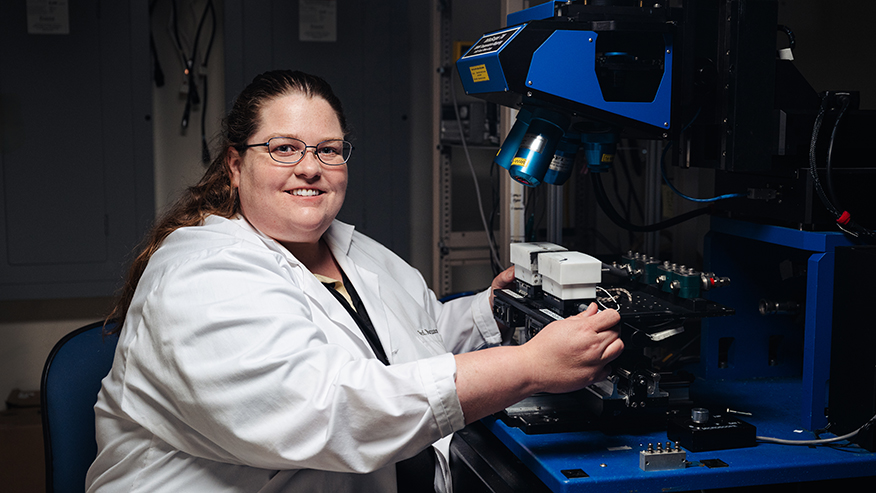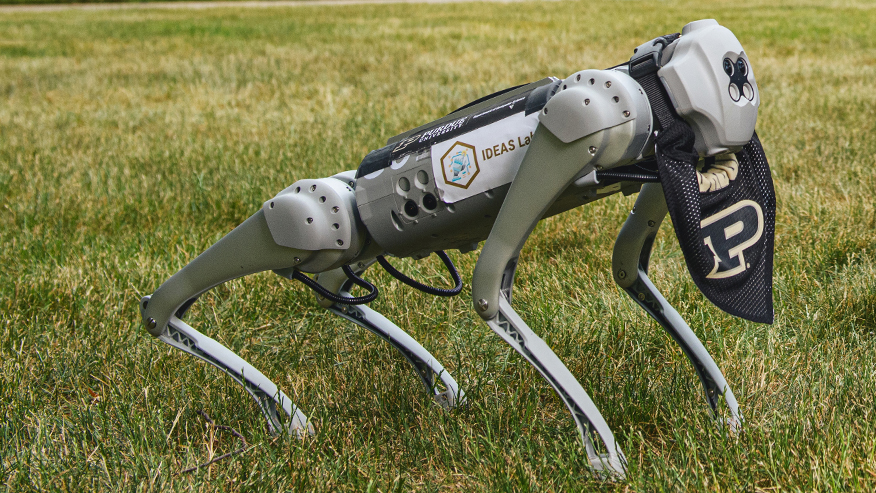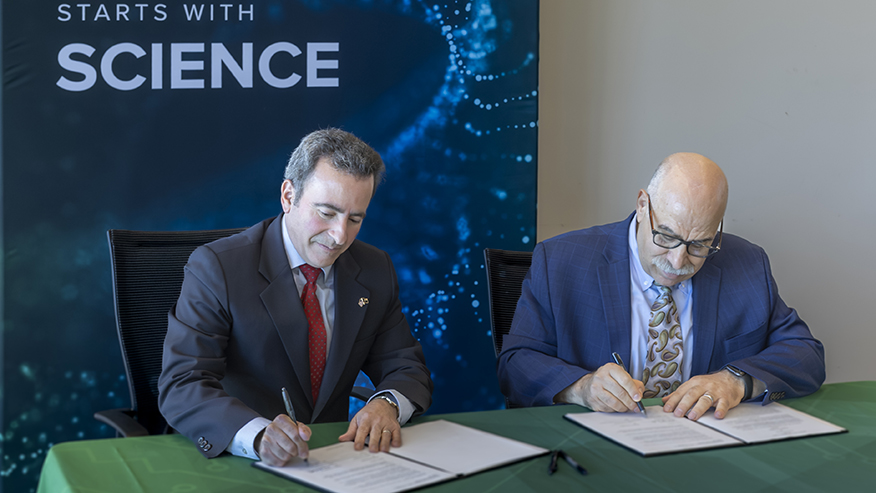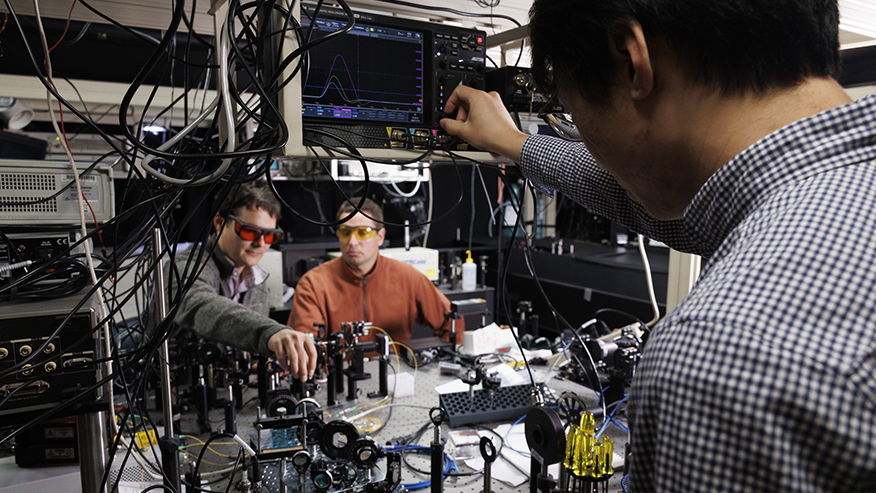New research focuses on keeping today’s hottest electronics cool for users at nanoscale level
Thermal management works to absorb, dissipate heat created by chips in handheld phones and electric vehicles

Amy Marconnet, professor of mechanical engineering, uses an infrared camera in her lab at Birck Nanotechnology Center at Purdue. Her research looks into new methods to manage and reduce the heat produced inside many of today’s electronics. (Purdue University photo/Greta Bell)
WEST LAFAYETTE, Ind. — Keeping today’s electronics cool isn’t as easy as running a fan installed at the rear of a desktop computer. Using anything from a smartphone to an electric vehicle results in some manner of heat production that eventually leads to the deterioration of the device.
Amy Marconnet, professor of mechanical engineering at Purdue University, is researching today’s wide range of technology to develop electronics cooling and thermal management techniques focusing on reducing the heat that’s produced, potentially resulting in improved device power and usage.
Electronics have a narrow temperature range where they can function efficiently. In an ever-evolving era of technology, there are a variety of ways to keep devices cool, even at a nanoscale level.
“On the semiconductor side, we’re mainly looking at improving thermal management to let electronics run at higher powers,” Marconnet said. “With wearable electronics, there’s tighter temperature controls required because it’s directly in contact with people at all times or when it’s in use and getting hot.”
That requirement has resulted in researching materials that can better transfer the heat in a system away from where it is building up without adding additional weight or manufacturing costs to the device.
Marconnet said phase change materials are one option her research is delving into. The materials provide thermal management by absorbing or releasing heat during the transition between melting or solidifying, depending upon the conditions. They also are being researched for the power electronics in electric vehicles.
“So, you can have the materials be melting while you’re, say, using your VR (virtual reality) goggles,” she said. “And then when you’re recharging your goggles or overnight, they will solidify, and you can use the device with higher intensity the next day.”
By melting, the phase change materials absorb the heat being produced, while solidifying again releases the heat. Marconnet recently researched using a metallic alloy as a phase change material within a chip to keep the system compact, yet effective. This work was spearheaded by Marconnet’s graduate student Meghavin Bhatasana.
Marconnet’s work receives funding from a consortium of companies as part of the Cooling Technologies Research Center at Purdue. She has published previous papers on thermal greases, a pastelike material that is put between a silicon chip and the heat-spreading components in the system.
Thermal greases eventually are “pumped out” of the area between the chips and other components, causing a device like a computer to drop in performance.
“We’re trying to figure out a fast test method right now for identifying which materials will perform well and which will perform poorly without having to wait for a year or more of an actual use of the system,” Marconnet said.
Thermal management also examines the part batteries play in heat buildup, especially as the demand increases for faster charges, particularly in electric vehicles.
Marconnet compared heat buildup from charging a device battery to the light from an incandescent light bulb. While you get useful light from the bulb, it also gets hot. When charging a battery, you also get useful power, but heat is generated by the battery’s electrochemical reactions. So, while some of the power is being used for the chemical reactions that charge the battery, another portion of the power just gets wasted as heat in the device.
Marconnet and Xiulin Ruan, a professor in the School of Mechanical Engineering, already have worked to extend the life of devices by creating a compressible foam that can spread out heat building up as well as offer insulation against colder temperatures. The Purdue Innovates Office of Technology Commercialization has filed a patent application for it.
Two new papers regarding Marconnet’s work on phase change materials have been submitted and are under review.
Purdue is a national leader in research and education involving microelectronics materials, devices, chip design, tool development, manufacturing, packaging and sustainability, spanning the semiconductor ecosystem in software and hardware with long-standing faculty excellence. Strategic initiatives — such as the first comprehensive, large-scale Semiconductor Degrees Program, announced by Purdue in 2022 — are intended to prepare the next generation of semiconductor industry workers, a cornerstone for advancing the field.
About Purdue University
Purdue University is a public research institution demonstrating excellence at scale. Ranked among top 10 public universities and with two colleges in the top four in the United States, Purdue discovers and disseminates knowledge with a quality and at a scale second to none. More than 105,000 students study at Purdue across modalities and locations, including nearly 50,000 in person on the West Lafayette campus. Committed to affordability and accessibility, Purdue’s main campus has frozen tuition 13 years in a row. See how Purdue never stops in the persistent pursuit of the next giant leap — including its first comprehensive urban campus in Indianapolis, the Mitch Daniels School of Business, Purdue Computes and the One Health initiative — at https://www.purdue.edu/president/strategic-initiatives.
Papers
Experimental Investigation of Composite Phase Change Material Heat Sinks for Enhanced Passive Thermal Management
ASME Journal of Heat and Mass Transfer
DOI: https://doi.org/10.1115/1.4048620
Machine-learning assisted optimization strategies for phase change materials embedded within electronic packages
Applied Thermal Engineering
DOI: https://doi.org/10.1016/j.applthermaleng.2021.117384
Optimization of an Embedded Phase Change Material Cooling Strategy Using Machine Learning
2021 20th IEEE Intersociety Conference on Thermal and Thermomechanical Phenomena in Electronic Systems (iTherm)
DOI: https://doi.org/10.1109/ITherm51669.2021.9503128
Media contact: Brian Huchel
Note to journalists:
A video link is available to media who have an Associated Press subscription.



